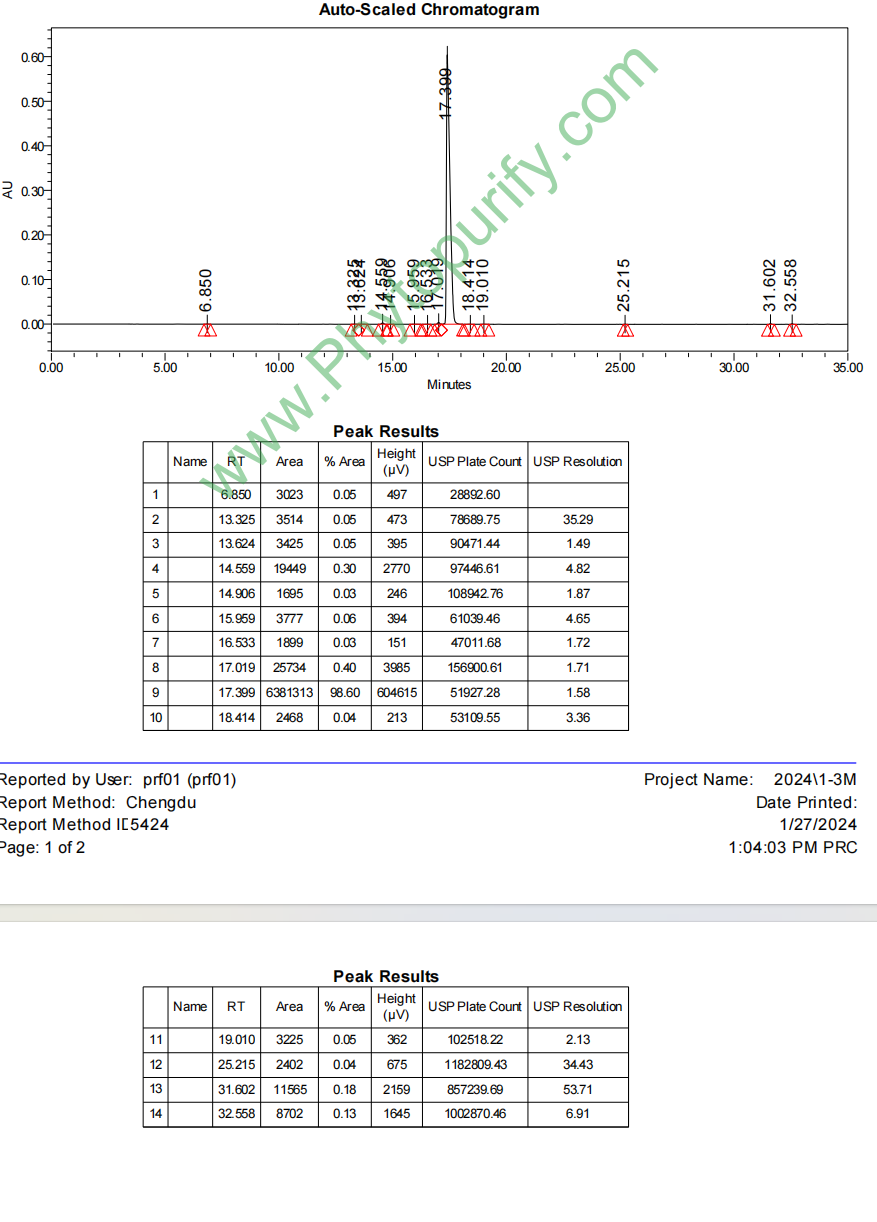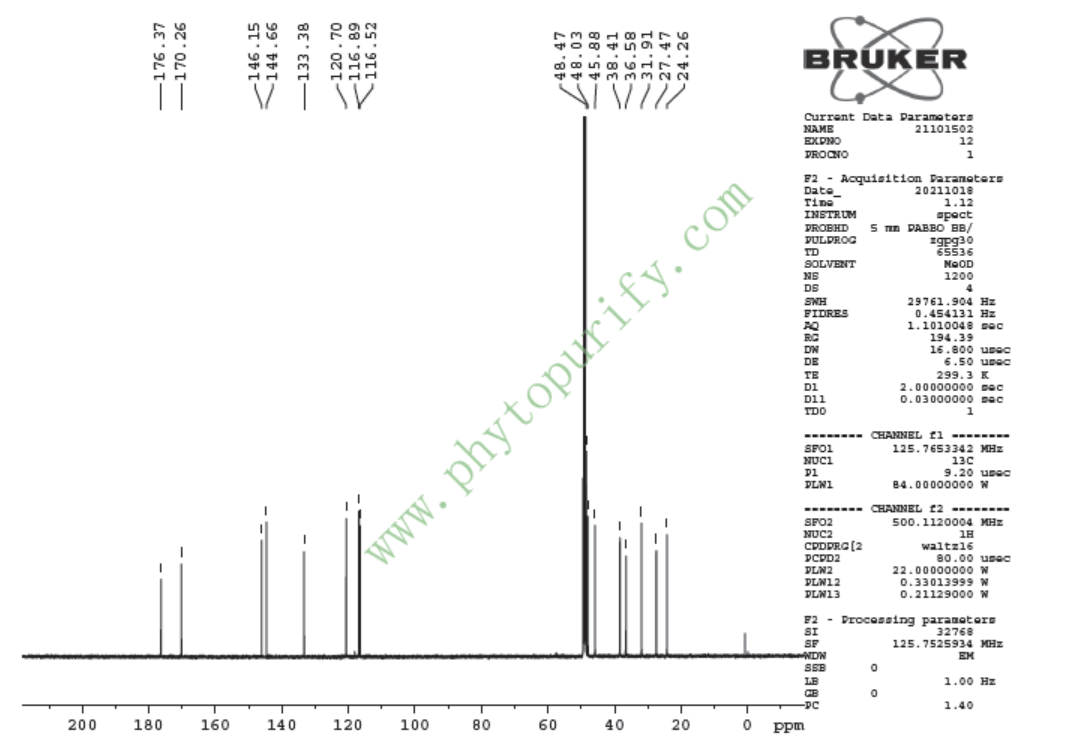
Kukoamine ACAS No.:75288-96-9
|
||||||||||
 |
|
|
||||||||

| Catalogue No.: | BP0833 |
| Formula: | C28H42N4O6 |
| Mol Weight: | 530.666 |
Product name: Kukoamine A
Synonym name: Kukoamine A Acetate
Catalogue No.: BP0833
Cas No.: 75288-96-9
Formula: C28H42N4O6
Mol Weight: 530.666
Botanical Source: Lycii Cortex
Physical Description:
Type of Compound: Alkaloids
Purity: 95%~99%
Analysis Method: HPLC-DAD or/and HPLC-ELSD
Identification Method: Mass, NMR
Packing: Brown vial or HDPE plastic bottle
Storage: Store in a well closed container, protected from air and light. Put into refrigerate or freeze for long term storage.
Whenever possible, you should prepare and use solutions on the same day. However, if you need to make up stock solutions in advance, we recommend that you store the solution as aliquots in tightly sealed vials at -20℃. Generally, these will be useable for up to two weeks.
The product could be supplied from milligrams to grams
Inquire for bulk scale.
Description:
Kukoamine A possesses anticancer, cytoprotective, antioxidant, and anti-inflammatory activities, it also has neuroprotective effects through inhibiting oxidative stress and apoptosis after whole-brain irradiation (WBI) in rats. Kukoamine A prevents radiation-induced neuroinflammation and preserves hippocampal neurogenesis in rats by inhibiting activation of NF-κB and AP-1. It attenuates insulin resistance and fatty liver through downregulation of Srebp-1c.
References:
Journal of Enzyme Inhibition and Medicinal Chemistry, 2009, 24(5):1188-1193.
Kukoamine A analogs with lipoxygenase inhibitory activity.
Kukoamine A (KukA) is a spermine (SPM) conjugate with dihydrocaffeic acid (DHCA), with interesting biological activities.
METHODS AND RESULTS:
The four possible regioisomers of KukA, as well as a series of KukA analogs incorporating changes in either the SPM or the DHCA structural units, were evaluated for their antioxidant activity and their inhibitory activity on soybean lipoxygenase (LOX) and lipid peroxidation. The reducing properties of the compounds were evaluated using the 1,1-diphenyl-2-picrylhydrazyl (DPPH) free radical scavenging assay and found to be in the range 5-97.5%. KukA significantly inhibits LOX with IC(50) 9.5 mu M. All tested analogs inhibited lipid peroxidation in the range of 11-100%.
CONCLUSIONS:
The most potent compounds KukA and its analog 3, in which the DHCA units had been replaced by O,O'-dimethylcaffeic acid units, were studied for their anti-inflammatory activity in vivo on rat paw edema induced by carrageenan and found to be of comparable activity to indomethacin. The results of the biological tests are discussed in terms of structural characteristics.
Molecules, 2018, 23(4):973.
Antioxidant and Cytoprotective Effects of Kukoamines A and B: Comparison and Positional Isomeric Effect.
METHODS AND RESULTS:
In this study, two natural phenolic polyamines, Kukoamine A and kukoamine B, were comparatively investigated for their antioxidant and cytoprotective effects in Fenton-damaged bone marrow-derived mesenchymal stem cells (bmMSCs). When compared with kukoamine B, Kukoamine A consistently demonstrated higher IC50 values in PTIO•-scavenging (pH 7.4), Cu2+-reducing, DPPH•-scavenging, •O2−-scavenging, and •OH-scavenging assays. However, in the PTIO•-scavenging assay, the IC50 values of each kukoamine varied with pH value. In the Fe2+-chelating assay, kukoamine B presented greater UV-Vis absorption and darker color than kukoamine A. In the HPLC–ESI–MS/MS analysis, Kukoamine A with DPPH• produced radical-adduct-formation (RAF) peaks (m/z 922 and 713). The 3-(4,5-Dimethylthiazol-2-yl)-2,5-diphenyl (MTT) assay suggested that both kukoamines concentration-dependently increased the viabilities of Fenton-damaged bmMSCs at 56.5–188.4 μM. However, Kukoamine A showed lower viability percentages than kukoamine B.
CONCLUSIONS:
In conclusion, the two isomers Kukoamine A and kukoamine B can protect bmMSCs from Fenton-induced damage, possibly through direct or indirect antioxidant pathways, including electron-transfer, proton-transfer, hydrogen atom transfer, RAF, and Fe2+-chelating. Since kukoamine B possesses higher potentials than Kukoamine A in these pathways, kukoamine B is thus superior to Kukoamine A in terms of cytoprotection. These differences can ultimately be attributed to positional isomeric effects.
Neurochemistry International, 2017:S0197018616301875.
Neuroprotective effects of Kukoamine A against cerebral ischemia via antioxidant and inactivation of apoptosis pathway.
Kukoamine A (KuA) is a bioactive compound, which is known for a hypotensive effect. Recent studies have shown that KuA has anti-oxidative effect and anti-apoptosis stress in vitro. However, its neuroprotective effect in rats with cerebral ischemia is still unclear.
METHODS AND RESULTS:
In the study, we investigated whether KuA could attenuate cerebral ischemia induced by permanent middle cerebral artery occlusion (pMCAO) in rats. Results revealed that KuA could significantly reduce infarct volume both pre-treatment and post-treatment, and increase corresponding Garcia neurological scores. Acute KuA postconditioning not only significantly reduced cerebral infarct volume, brain water content and improved neurological deficit scores, but also decreased the number of TUNEL-positive cells. Moreover, it markedly increased the activities of Cu/Zn-SOD and Mn-SOD, reduced levels of MDA and H2O2. Increased expressions of caspase-3, cytochrome c and the ratio of Bax/Bcl-2 were significantly alleviated with KuA treatment.
CONCLUSIONS:
These findings demonstrated that KuA was able to protect the brain against injury induced by pMCAO via mitochondria mediated apoptosis signaling pathway.
HPLC of Kukoamine A

NMR of Kukoamine A
